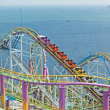by Christopher Gannatti, CFA Global Head of Research, WisdomTree
Key Takeaways
- In August 2024, gold prices reached a new record high of more than $2,500, driven by factors such as excessive government spending, debt burdens and geopolitical tensions.
- Gold is seen as a hedge against a weaker fiat currency, with significant purchases by central banks and a cultural preference for physical gold in countries like India.
- The WisdomTree Efficient Gold Plus Equity Strategy Fund (GDE) combines 90% exposure to U.S. equities and 90% to gold futures, offering a leveraged exposure that can potentially enhance returns but also increase volatility. The correlation between these different asset class returns, in our opinion, makes this marriage particularly interesting.
In August 2024, the price of gold eclipsed $2,500, a new record high.1 It’s amazing to consider this metal has been culturally significant in financial transactions for thousands of years.
In figure 1, we look back to 2000 and note the percentage change in gold prices. The year-to-date 2024 figure of 19%—which led to the record high—is not an extreme outlier. There are many different reasons that investors allocate to gold.2
- We continue to hear about excessive government spending and the debt burden—and this year’s election does not portend a direction change. Gold is viewed as a way to hedge against a weaker fiat currency.
- There are examples of countries, like India, where citizens appreciate holding physical gold, typically in the form of jewelry.
- Central banks have been significant buyers of gold and that increased after the U.S. government sanctioned the Russian government through Russia’s U.S. dollar-based reserves. Putting aside any views on the Russia/Ukraine conflict, once the U.S. government decided to open this Pandora’s box, it changed the decision calculus for all countries seeking to keep a proportion of their reserves in U.S. dollars.2
It's difficult to know the “right” price level for gold at a given time, though it is interesting that in the 24 years from 2000 to 2023, five exhibited negative returns, and only two out of those exhibited negative returns in the double-digit percentages.
Figure 1: Calendar Year Returns for Gold (2000 to 2024 YTD)

Source: Bloomberg. 2024 refers to the period 1/1/24–8/22/24. Past performance is not indicative of future results.
Efficient Gold Plus Equity Strategy
The typical way to build a portfolio is to think in terms of allocating 100% of a pie chart. A 60/40 portfolio tends to mean 60% in equities, 40% in fixed income. Some slice in a certain percentage to commodities or to gold.
There is no right or wrong allocation. But there are some ways to make portfolios go further than the typical limits of a 100% allocation.
WisdomTree developed a range of strategies based on the concept of stacking assets using prudent and capital-efficient leverage through futures.
Ultimately, there is no reason why, in one exchange-traded fund (ETF), one cannot allocate beyond 100%, thereby getting a greater notional exposure relative to every dollar invested.
Thinking of the WisdomTree Efficient Gold Plus Equity Strategy Fund (GDE) as an example:
- The foundation is exposure to the 500 largest U.S. equities by market capitalization, like any equity ETF. In this case, exposure to these stocks represents 90% of the total exposure.
- There is an overlay, such that there is an equal—an additional 90%—exposure to gold futures contracts. The equity exposure and the gold futures exposure, equal in magnitude, now combine such that the total exposure is 180% of the nominal investment.
- To serve as collateral for the gold futures, 10% of the allocation is in U.S. Treasury bills.
If an investor placed $100 into GDE, their return experience would be based on $180 of notional exposure, with 50% driven by large-cap U.S. equities and 50% driven by gold futures.
- These are long exposures, meaning that the investor benefits if the gold futures and the equities exhibit positive returns and the investor loses money if they exhibit negative returns.
- This is a leveraged exposure. Leverage can increase portfolio volatility. An important part of the return experience, however, will be based on how the U.S. equities and the gold futures are moving relative to each other.
Morningstar U.S. Fund Large Blend Category
GDE is in the Morningstar U.S. Fund Large Blend category, so we started by posing the question—what are the three largest ETFs in this category by assets under management?
- SPDR S&P 500 ETF Trust (SPY): This strategy is designed to track, after fees and expenses, the total return performance of the S&P 500 Index.
- iShares Core S&P 500 ETF (IVV): This strategy is designed to track, after fees and expenses, the total return performance of the S&P 500 Index.
One might say—why include two funds that track the same underlying index? On August 22, 2024, there was nearly $560 billion in SPY and nearly $514 billion in IVV.3 When we talk about these two funds, we are talking about more than $1 trillion in investor assets, and it is almost evenly split between them. It’s clear that each is providing a use-case for investors.
- Vanguard Dividend Appreciation Index Fund (VIG): This strategy is designed to track, before fees and expenses, the total return performance of the S&P U.S. Dividend Growers Index. This index measures the performance of U.S. companies that have followed a policy of consistently increasing dividends every year for at least 10 consecutive years. The top 25% highest-yielding dividend-payers are excluded from the index.4
We also wanted to recognize that the performance of gold is central to this discussion, in that we previously noted the key drivers of GDE's returns. The largest ETF option for investors seeking exposure to gold is the SPDR Gold Shares (GLD).
We wanted to explore how the performance of GDE compared to the performance of these four large and widely followed ETFs.
Figure 2: Standardized Returns

Source: WisdomTree, specifically data from the Fund Comparison Tool in the PATH suite of tools, 6/30/24. NAV denotes total return
performance at net asset value. MP denotes market price performance. Past performance is not indicative of future results.
Investment return and principal value of an investment will fluctuate so that an investor’s shares, when redeemed, may be
worth more or less than their original cost. Current performance may be lower or higher than the performance data quoted. For
the most recent month-end and standardized performance and to download the respective Fund prospectuses, click here.
The Path Dependency of Returns
When considering the returns of GDE, one must hold in mind:
- The returns of the top 500 U.S. equities weighted by market cap.
- The returns of gold futures contracts.
- The returns of U.S. Treasury bills.
- The correlation of returns of these three distinct asset classes against each other over the period.
We look at GDE's returns against SPY, IVV, VIG and GLD over three distinct periods:
- 2022: GDE's inception was March 17, 2022, so we look at the available history during this year even if we cannot include the full year. 2022 was a difficult return year for U.S. equities5 and U.S. fixed income.6
- 2023
- 2024: Up to August 22, 2024, when we began writing this piece.
Generally speaking, if the price of gold is stable to rising and U.S. equities are doing well, this is a better environment for GDE. If the price of gold is volatile and falling and U.S. equities are trending more in the negative direction, this is a worse environment for GDE.
For the available history of 2022:
- GDE lagged all of the strategies shown. Equities had a tougher time generating returns over this period, and GLD was down slightly.
- The difference in returns between GDE and both IVV and SPY (since they track the same underlying index it is tough to see distinction between the lines in a line chart), was roughly 5% over this period.
Figure 3: 2022’s Available History

Source: WisdomTree, specifically data from the Fund Comparison Tool in the PATH suite of tools, as of 8/22/24. NAV denotes total return
performance at net asset value. MP denotes market price performance. Past performance is not indicative of future results. Investment
return and principal value of an investment will fluctuate so that an investor’s shares, when redeemed, may be worth more or less
than their original cost. Current performance may be lower or higher than the performance data quoted. For the most recent month-
end and standardized performance and to download the Fund prospectus, click here.
2023 saw:
- GDE outperforming all of the strategies shown. One must remember that this was the year where we collectively coined the term “Magnificent 7” because those very large U.S. companies were delivering returns that were so strong relative to the rest of equity markets.
- GLD delivered a return in the vicinity of 15%.
Positive equity returns and gold price appreciation was a pretty good environment for GDE, overall.
Figure 4: 2023—A Year of Large-Cap U.S. Equities and Some Gold Price Appreciation

Source: WisdomTree, specifically data from the Fund Comparison Tool in the PATH suite of tools, as of 8/22/24. NAV denotes total return
performance at net asset value. MP denotes market price performance. Past performance is not indicative of future results. Investment
return and principal value of an investment will fluctuate so that an investor’s shares, when redeemed, may be worth more or less
than their original cost. Current performance may be lower or higher than the performance data quoted. For the most recent month-
end and standardized performance and to download the Fund prospectus, click here.
In 2024 so far, we see:
- GDE outperforming all of the strategies shown. U.S. equities have been delivering largely positive returns, excusing the large but short-lived drawdown in early August 2024. Gold’s price has attained levels above $2,500 for the first time in history, contributing to GLD also putting up a return in the vicinity of 20%.
Figure 5: 2024 Period So Far…

Source: WisdomTree, specifically data from the Fund Comparison Tool in the PATH suite of tools, as of 8/22/24. NAV denotes total return
performance at net asset value. MP denotes market price performance. Past performance is not indicative of future results. Investment
return and principal value of an investment will fluctuate so that an investor’s shares, when redeemed, may be worth more or less
than their original cost. Current performance may be lower or higher than the performance data quoted. For the most recent month-
end and standardized performance and to download the Fund prospectus, click here.
Now, even if IVV, SPY and VIG represent well over $1 trillion on their own, the Morningstar U.S. Fund Large Blend Category has a lot of other strategies within it. In figure 6, we see that GDE was in the first percentile, as of June 30, 2024, which means that over these periods it has generated better returns than 99% of the other funds in this category (over 1,400).
We know that the explanation for these results is the fact that the typical fund in this group would be exposed solely to U.S. equities and would not have a gold futures overlay. Still, Morningstar has placed GDE into this category, and we do believe that many investors allocate to U.S. equities and gold, but they typically do it separately. GDE offers a way to allocate to gold and U.S. equities in the same vehicle and free up capital to invest in other areas. Remember—for every $100 of nominal exposure, the notional investment is exposed to $180 ($90 in U.S. equities and $90 in gold futures).
Figure 6: GDE’s Rank in Morningstar’s U.S. Fund Large Blend Category

Source: Morningstar, as of 6/30/24 (YTD performance through 6/30/24).
US Fund Large Blend. Morningstar, Inc. All rights reserved. The
information contained herein: (1) is proprietary to Morningstar and/or
its content providers; (2) may not be copied or distributed; and (3) is not
warranted to be accurate, complete or timely. Neither Morningstar nor
its content providers are responsible for any damages or losses arising
from any use of this information. Past performance, rankings and ratings
are no guarantee of future results. Regarding ranking of funds, 1 = Best.
Morningstar rankings are based on a fund's average annual total return
relative to all funds in the same Morningstar category. Fund performance
used within the rankings, reflects certain fee waivers, without which,
returns and Morningstar rankings would have been lower. The highest
(or most favorable) percentile rank is 1 and the lowest (or least favorable)
percentile rank is 100.
Figure 7: Other Important Information

Sources: WisdomTree, Morningstar, as of 8/23/24.
1 Source: Leslie Hook & Harry Dempsey, “Gold Hits Record Highs as Investors Bet on Rate Cuts,” Financial Times, 8/21/24.
2 Source: McCauley et al, “The Russian Sanctions and Dollar Foreign Exchange Reserves,” VOXEU Column, 7/29/24.
3 Source: Morningstar.
4 Source: https://www.spglobal.com/spdji/en/indices/dividends-factors/sp-us-dividend-growers-index/#overview
5 Refers to the S&P 500 Index.
6 Refers to the Bloomberg U.S. Aggregate Index.
Copyright © WisdomTree















